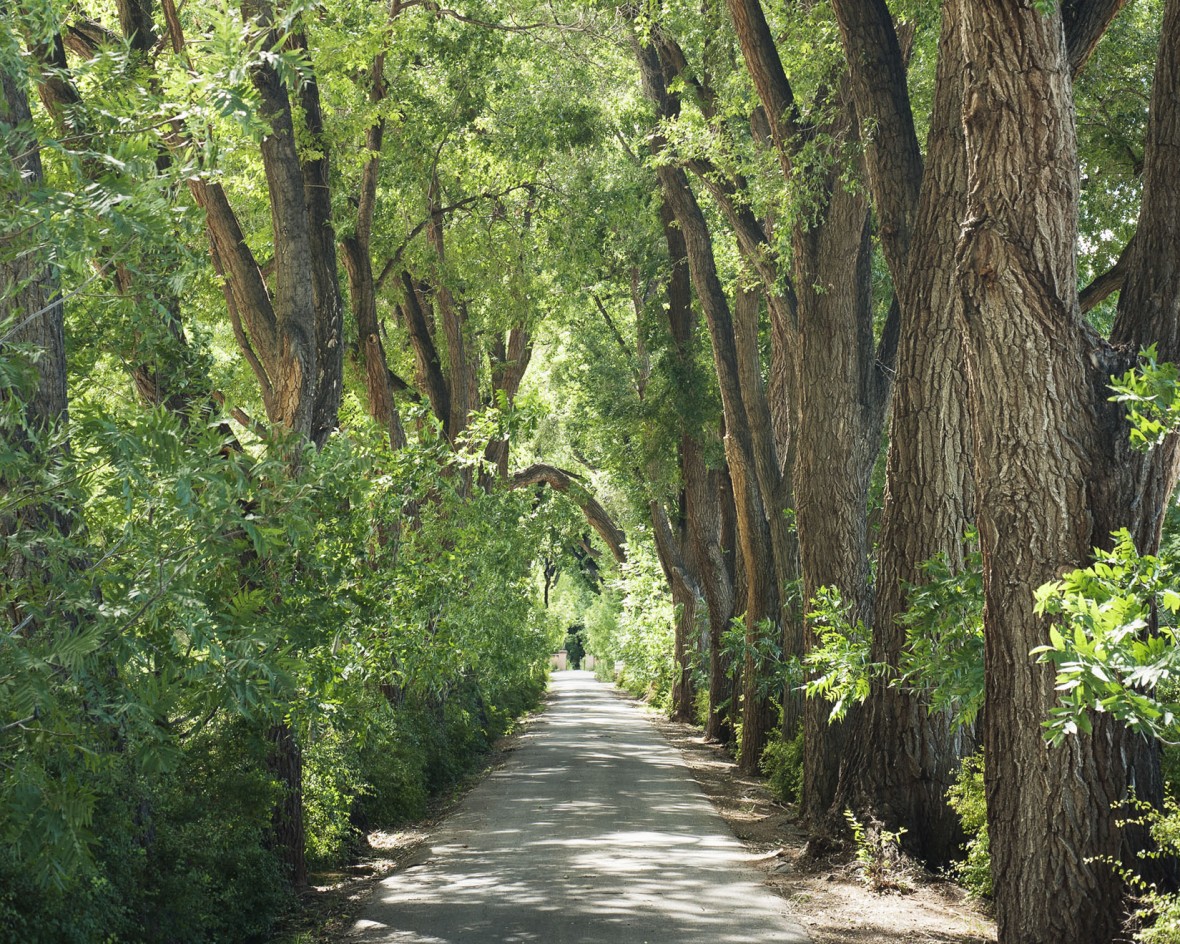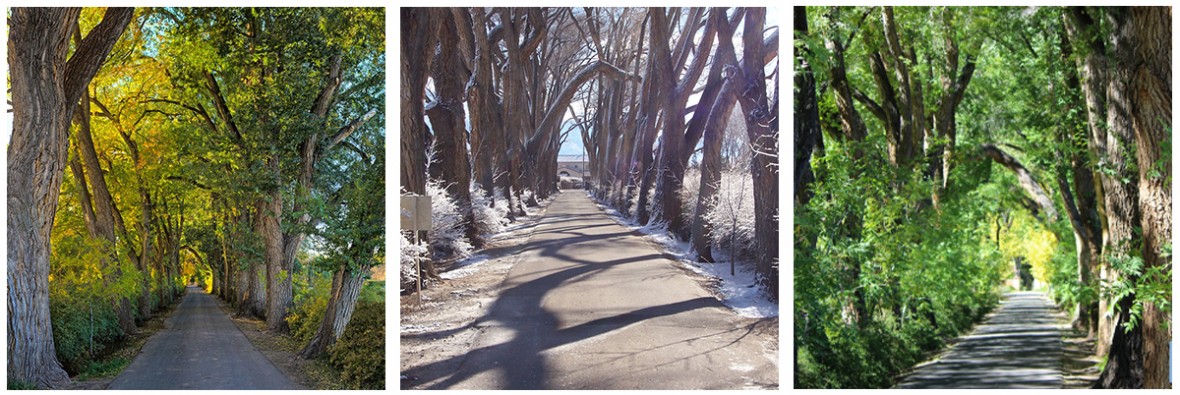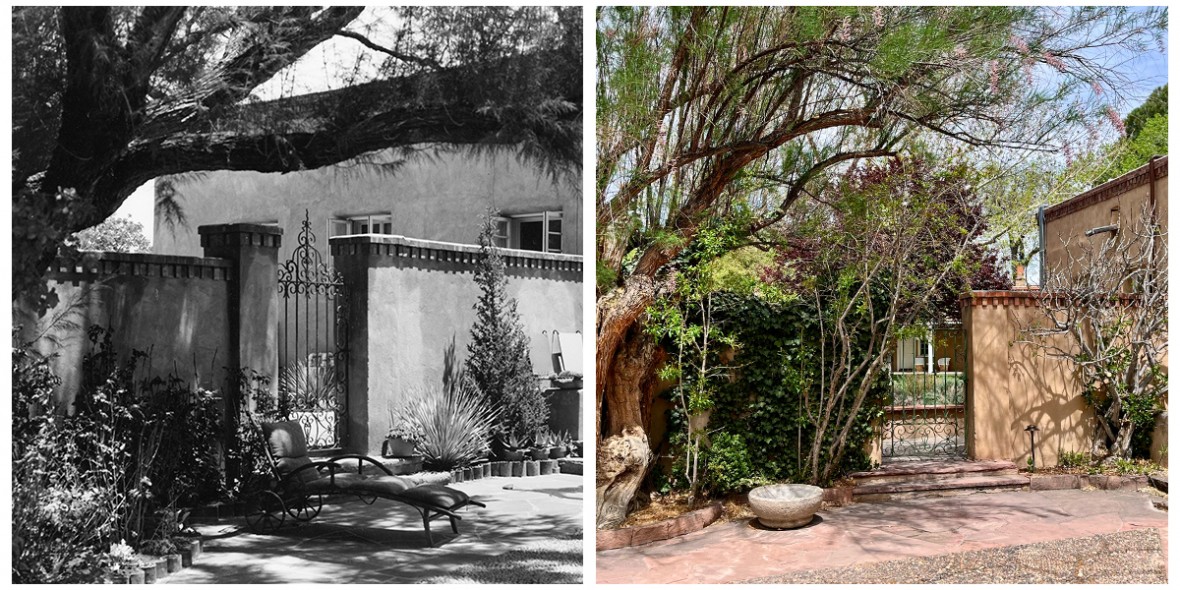
On Arbor Day, we pause to honor the quiet strength and generosity of trees. At Los Poblanos, trees are far more than a scenic backdrop — they are central to our regenerative farming practices, ecological philosophy and deep sense of place in the Rio Grande Valley.
Across the property, trees create microclimates that shield tender crops, shelter wildlife and shape the rhythm of the seasons. From flowering orchard to shaded bosque, their presence supports our regenerative agriculture and sustainable land management practices in the high desert landscape of Albuquerque’s North Valley.
 Los Poblanos driveway through the seasons.
Los Poblanos driveway through the seasons.A living canopy
The towering Siberian elms that line our iconic driveway were planted nearly 90 years ago to offer shade and structure. While these trees have fallen out of ecological favor in the Rio Grande watershed due to their prolific self-seeding, they continue to define the graceful entrance to our historic property, offering dappled light and arching branches.
In the gardens and fields, trees offer far more than beauty. They serve as windbreak systems and help create tree-supported microclimates essential for soil health and biodiversity. Early spring blossoms — especially from our cherry, quince, peach and apricot trees — support native pollinators, while birds and beneficial insects rely on the habitat these trees provide. Downed branches are chipped into mulch to preserve water and suppress weeds, part of a closed-loop system that reflects our commitment to eco-conscious tree care.
Deep roots in the bosque
Beyond our cultivated fields, the Rio Grande bosque forms one of the largest continuous riparian habitats in North America. This rare ecosystem — shaped by centuries of traditional acequia irrigation and natural flooding cycles — supports an abundance of life. Towering cottonwoods, native willows and migrating birds all contribute to the biodiversity of this living corridor, a vital ecological thread connecting land and water through time.
 Some of Los Poblanos fruit trees, from left to right: hawthorn, quince, apple and pomegranate.
Some of Los Poblanos fruit trees, from left to right: hawthorn, quince, apple and pomegranate.The evolving orchard
Los Poblanos is home to a diverse collection of fruiting trees, each chosen for its resilience, beauty and culinary potential. Throughout the property you will find mulberry, cherry, peach, apple, fig, pomegranate, jujube, hawthorn, persimmon and quince trees, thoughtfully planted to support seasonal harvests and kitchen creativity.
Figs and pomegranates, both native to the Mediterranean, have proven particularly well-suited to our modest water budget and warming climate. These fruiting trees thrive in the newer gardens, where they provide both architectural structure and flavorful bounty. Look for them in seasonal recipes such as stuffed figs and pomegranate seed vinaigrette.
The purple leaf plum tree, planted during the expansion of the Meem Rooms, is among the first to bloom in spring. Its delicate pink flowers signal the changing season, and if the frosts hold off, small burgundy plums develop — a favorite for preserving and cocktail infusions.
The weeping mulberry, now growing adjacent to the Inn Lobby, was carefully excavated and relocated by crane during construction of the Meem Rooms, Farm Suites and Barn Commons. It now thrives beside another mulberry tree between the greenhouse and Farm Shop, together producing luscious fruit each summer for the LP kitchens.
Challenges and care
Tree care in the arid Southwest comes with no shortage of challenges. Prolonged drought, invasive pests and early snowstorms all take a toll. The age of many legacy trees means some are reaching the end of their natural lives — a loss that feels deeply personal to those who have cared for them. Losing a century-old tree is like saying goodbye to an old friend.
Water scarcity remains a critical concern, especially as acequia water becomes less predictable year to year. Our horticulture team works closely with the landscape to adapt regenerative landscape practices to the realities of climate change — from soil conditioning and native species restoration to climate-resilient tree selection and orchard ecology.
In the coming years, we have plans to remove allelopathic black walnuts, continue replanting fruit varieties and carefully reimagine the driveway allée — ensuring future generations of trees serve the land as thoughtfully as those that came before.
 A Salt Cedar, photographed by Laura Gilpin in the 1930s continues to thrive today.
A Salt Cedar, photographed by Laura Gilpin in the 1930s continues to thrive today. The historic landscape
The trees at Los Poblanos are not only functional but also deeply connected to the cultural landscape and history of the Rio Grande Valley. Many of these trees are documented in Judith Philip's comprehensive book, The Gardens of Los Poblanos.
In the ceremony garden at La Quinta, an allée of trademarked Lacebark Elms references the historic Siberian elm allée. Chosen for their pest resistance and smaller mature size, these trees represent the evolution of sustainable land design in the Southwest.
The Chinese Pistache, planted on the west terrace of the hacienda, provides summer shade and brilliant autumn color. It is among the few truly heat- and drought-tolerant mid-sized trees, now widely used across Albuquerque as the urban heat island effect intensifies with climate change. Its deep roots preserve the surrounding 1930s pebble mosaics — a marriage of ecological and historical preservation.
A Salt Cedar, located outside the entrance to the Greely Garden, is believed to be one of the oldest in the valley. Introduced to New Mexico in the early 1900s for erosion control, it quickly became a popular ornamental tree thanks to its pale pink wispy blooms and tolerance of difficult conditions. In the 1930s it was photographed by Laura Gilpin, whose gelatin silver print still captures its presence today.
In the west garden of La Quinta, a long boxwood parterre frames a silver maple, its longevity a testament to the power of acequia irrigation. Tall native pines and dogwood buffer the garden from the Griegos Lateral, while a resilient Scots Pine — planted during the 1970s era — continues to thrive near the Rio Grande Boulevard, adapting gracefully to challenging soils and climate.
Looking ahead
As we plan for the next generation of trees, we remain grounded in holistic land stewardship. Trees are both inheritance and investment. They require time, care and a long view — qualities that guide our work across this desert oasis.
This Arbor Day, we celebrate the trees that root us in place, support our ecosystem and add such depth to daily life at Los Poblanos. In their shade, we are reminded to look up, breathe deeply and care for what lasts.
We invite you to take a slow walk down the tree-lined driveway, explore the orchard in bloom or find the historic Salt Cedar by the Greely Garden. Or simply take a moment to sit beneath a towering Cottonwood and listen — to the birds, the wind and the generous stillness of nature.
To learn more about our regenerative landscape practices, join us for a guided farm tour or visit the Farm Shop to explore books, seeds and tools curated with the same care we bring to our fields.
